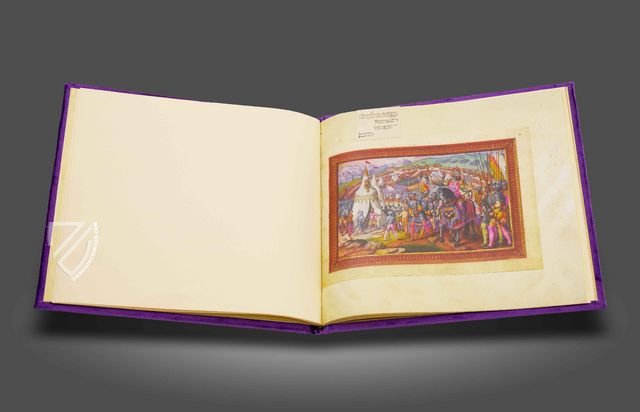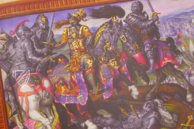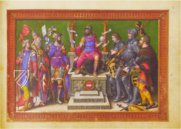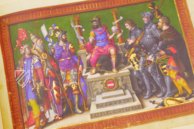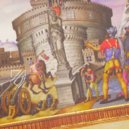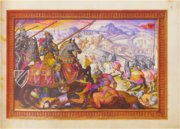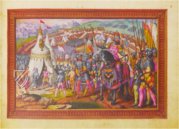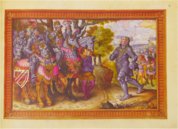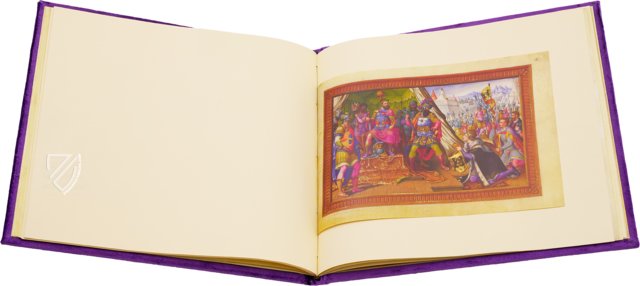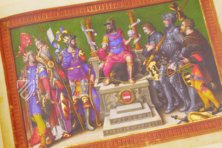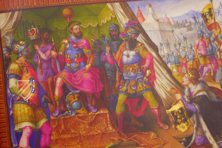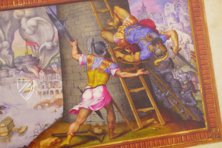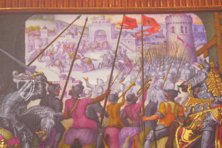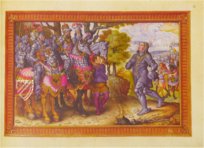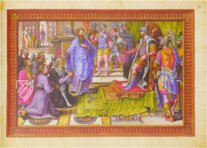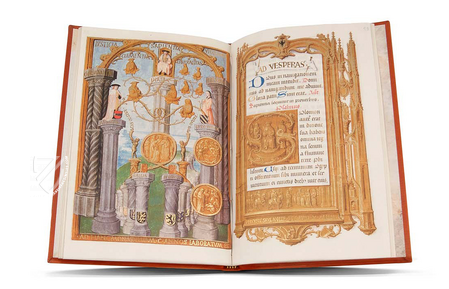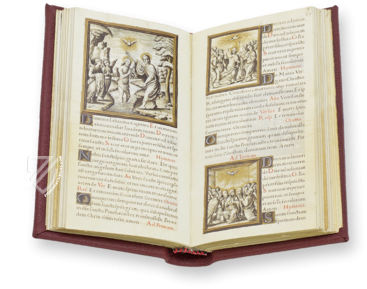Triumphs of Charles V
(3,000€ - 7,000€)
The Triumphs of Charles V is a historically and artistically significant testimony to the Early Modern Era. Twelve full-page miniatures of extraordinary quality show events from the reign of the great Habsburg Emperor Charles V (1500-1558), such as the Battle of Pavia or the Spanish expedition to America in 1530. Moreover, several important personalities of the 16th century, including Sultan Suleiman I (around 1495-1566), the French King Francis I (1494-1547) and Pope Clement VII (1478-1534), are brought together in this outstanding work of history. Commissioned by Charles' son and successor, King Philip II of Spain (1527-1598), the codex is also a political artwork, as it clearly visualizes claims to power and dependencies. Created in Italy by a successor of Giulio Clovio (1498-1578), the manuscript was first kept for centuries in the royal Cloister Library of San Lorenzo de El Escorial before being moved to England in the 19th century.
Triumphs of Charles V
With the Triumphs of Emperor Charles V, lay an historical as well as artistically important testimony of the 16th century. Twelve whole page miniatures of extraordinary quality show events from the ruler ship of the greatest Habsburg Emperor, Charles V. An important personality of his time, Sultan Suleiman, the French King Francis I, and Pope Clement VII are all united in this distinguished work of history. It arose in the second half of the 16th century by the patronage of Charles’ son and heir, the future King Philip II of Spain. It was contained within the royal Cloister Library of San Lorenzo de El Escorial, before it was later in the 19th moved to England.
A Work of History in Grandiose Images
In 36 pages, important events of the rule of Emperor Charles V (1500–1558) in magnificent images are lead to the eye. Therefore it concerns itself with the triumphs of Charles, but also the Christian Monarchs of Europe, and even with Ottomans under the Sultan Suleiman I. Within the twelve whole-page miniatures, for example, is a depiction of coronation of the Emperor, with sword in one hand and the globus cruciger in the other as a symbol of his power and legitimation as a ruler, with an eagle sitting as the symbol of the Holy Roman Empire. He is surrounded by his adversaries: Sultan Suleiman the Magnificent, Pope Clement VII, Francis I of France, the Duke of Cleves, the Kurfürst of Saxony, and the Landgrave of Hessen are all by the depiction dependent on the Emperor through ropes that connect them, or ropes that bound them to him, by another interpretation. Other miniatures show the battle of Pavia in 1525, the death of the Duke of Bourbon by the so-called Sacco di Roma in 1527, Pope Clement VII during his imprisonment in Castel Sant’ Angelo in 1527, the first siege of Vienna by the Ottomans and the victory over Suleiman in 1529, the Spanish expedition to America in 1530, and finally, Charles moving into Tunis in 1535. Alongside that are drawings of the Duke of Cleves, the Duke of Saxony, and the Landgrave of Hessen, who were forced to bow to the Emperor after a lost battle.
Ruler and Warrior in Gold and Color
All of the historical events are illustrated through grandiose depictions of battles, wars, kings, rulers, knights, and noblemen. The warriors carry ostentatious armor, and even the horses are wonderfully decorated. Even before the cruel scenes, such as the depiction of the American expeditions, where enemies are skinned alive by the natives, dismembered, and then roasted over the fire, the artists never retreat back. Everything is dominated from an impressive color scheme - underscored trough the artistic input of gold - and spatiality. Worth mentioning is, for example, the depiction of the Mausoleum of Hadrian with its contents, the Ponte Sant’Angelo, next to the bride over the Tiber. The figures are reminiscent of the unbelievable physicality of the paintings of the Italian Renaissance-Master, Michelangelo. The distinguished artistic finish of the miniatures are made clear with the diversification of the depiction of various materials, including polished metals to fine ornamental fabrics, and soft furs as well as cooled marble.
Italian Renaissance Paintings Celebrating the Habsburg Emperor
Assumedly, the impressive paintings were the product of a student or successor to Giulio Clovios. The name of this great miniaturist of the Italian High Renaissance is ever directly connected with miniatures of the most extraordinary quality. In the latest research, the name Simonzio Lupi has been especially discussed. The pattern of the miniatures derives from a series of stabs, edited by Hieronymus Cock in 1556, and was finished with drawings from Maerten van Heemskerck. Therefore, it can be assumed that its origin is between 1556 and the end of 16th century. Accompanying the twelve miniatures are thirty, four lined verses in colorful borders. These borders are wonderfully decorated with architectural ornamentation, special stamps, and bizarre masks, which are likewise as colorful as the miniatures. The patron of the work was King Philip of Spain (1527–1598), the son of Charles V who then stored the historical work in the Cloister Library of San Lorenzo de El Escorial. The manuscript is an outstanding example of the artistic testimonies commissioned by Emperor Charles V and his successors to legitimate their rule.
Codicology
- Alternative Titles
- Triunfos de Carlos V
Triumphe Karls V.
Triomphes de Charles Quint
I Trionfi di Carlo V
Triunfos de Carlos V - Size / Format
- 36 pages / 29.0 × 20.0 cm
- Origin
- Italy
- Date
- Between 1556 and 1593
- Epochs
- Style
- Language
- Script
- Humanistic Minuscule
- Illustrations
- 12 full-page miniatures of achievements of Charles V and 13 four-line verses in colored frames
- Patron
- Philip II, King of Spain (1527–1598)
- Artist / School
- Simonzio Lupi
Maerten van Heemskerck
Dirck Volkertszoon Coornhert
Successor to Giulio Clovio - Previous Owners
- Library of Monastery of S. Lorenzo El Escorial
Monsieur Trochon (Paris)
Samuel Woodburn (London)
Thomas Grenville
Grenville Library
Triumphs of Charles V
Submission of the Duke of Saxony
The Schmalkaldic League was a mid-16th century alliance of Protestant princes within the Holy Roman Empire, which Charles decisively defeated at the Battle of Mühlberg on April 24th, 1547. Duke John Frederick I of Saxony, leader of the League, is pictured surrendering with a historically accurate wound on his left cheek, which would leave his face scarred for the rest of his life. He wears a coat of chainmail over his suit of armor and his horse is adorned with the black and gold bars of Saxony.
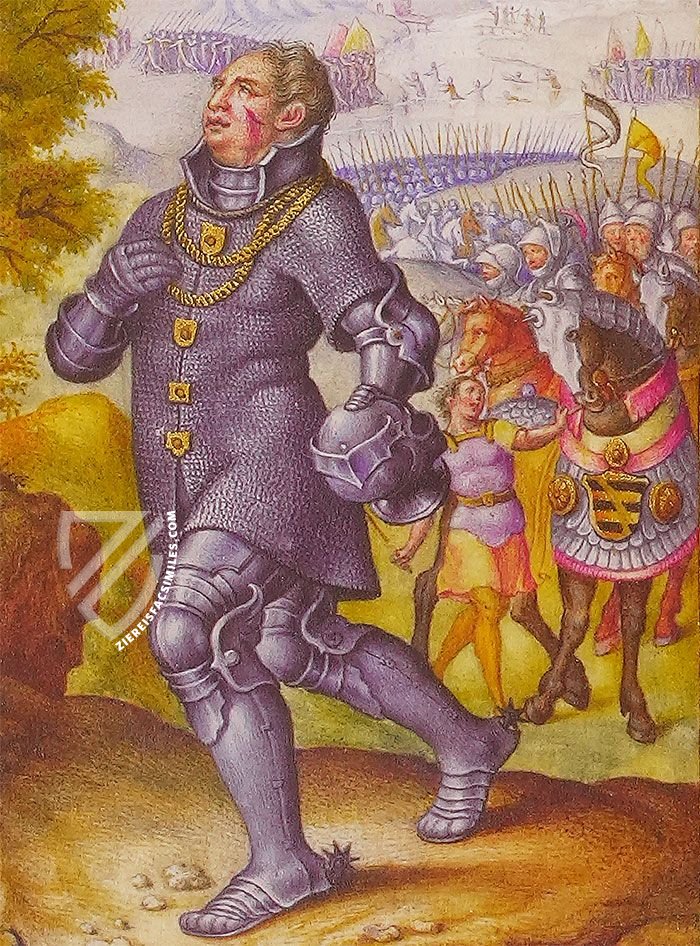
Triumphs of Charles V
The Emperor Enthroned Among his Enemies
The 16th century was an epoch of conflict among the emerging kingdoms and empires of Europe and the Near East with many strong personalities contending for power. With a globus cruciger in one hand and a sword in the other, Charles V is enthroned and flanked by six figures representing his greatest foes.
On the left side are Charles’ foreign enemies: the Ottoman Emperor Suleiman the Magnificent, Pope Clement VIII, and King Francis I of France. His enemies within the Holy Empire are lined up on the right: the Duke of Cleves, the Duke of Saxony, and the Landgrave of Hesse. Except for Suleiman, all of these figures are tied together by two golden chords bound together by an iron ring held in the beak of an imperial eagle between his legs.
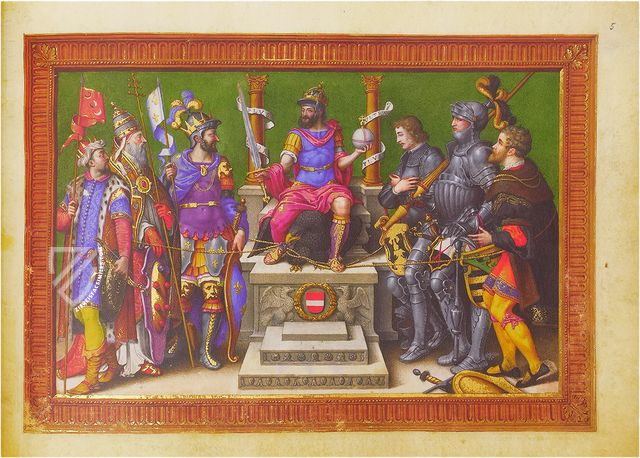
#1 Triunfos de Carlos V (Gold series)
Language: Spanish
(3,000€ - 7,000€)
- Treatises / Secular Books
- Apocalypses / Beatus
- Astronomy / Astrology
- Bestiaries
- Bibles / Gospels
- Chronicles / History / Law
- Geography / Maps
- Saints' Lives
- Islam / Oriental
- Judaism / Hebrew
- Single Leaf Collections
- Leonardo da Vinci
- Literature / Poetry
- Liturgical Manuscripts
- Medicine / Botany / Alchemy
- Music
- Mythology / Prophecies
- Psalters
- Other Religious Books
- Games / Hunting
- Private Devotion Books
- Other Genres
- Afghanistan
- Armenia
- Austria
- Belgium
- Colombia
- Croatia
- Cyprus
- Czech Republic
- Denmark
- Egypt
- Ethiopia
- France
- Germany
- Greece
- Hungary
- India
- Iran
- Iraq
- Israel
- Italy
- Japan
- Lebanon
- Luxembourg
- Mexico
- Morocco
- Netherlands
- Palestine
- Peru
- Poland
- Portugal
- Russia
- Serbia
- Spain
- Sri Lanka
- Sweden
- Switzerland
- Syria
- Turkey
- Ukraine
- United Kingdom
- United States
- Uzbekistan
- Aboca Museum
- Ajuntament de Valencia
- Akademie Verlag
- Akademische Druck- u. Verlagsanstalt (ADEVA)
- Aldo Ausilio Editore - Bottega d’Erasmo
- Alecto Historical Editions
- Alkuin Verlag
- Almqvist & Wiksell
- Amilcare Pizzi
- Andreas & Andreas Verlagsbuchhandlung
- Archa 90
- Archiv Verlag
- Archivi Edizioni
- Arnold Verlag
- ARS
- Ars Magna
- ArtCodex
- AyN Ediciones
- Azimuth Editions
- Badenia Verlag
- Bärenreiter-Verlag
- Belser Verlag
- Belser Verlag / WK Wertkontor
- Benziger Verlag
- Bernardinum Wydawnictwo
- BiblioGemma
- Biblioteca Apostolica Vaticana (Vaticanstadt, Vaticanstadt)
- Bibliotheca Palatina Faksimile Verlag
- Bibliotheca Rara
- Boydell & Brewer
- Bramante Edizioni
- Bredius Genootschap
- Brepols Publishers
- British Library
- C. Weckesser
- Caixa Catalunya
- Canesi
- CAPSA, Ars Scriptoria
- Caratzas Brothers, Publishers
- Carus Verlag
- Casamassima Libri
- Chavane Verlag
- Christian Brandstätter Verlag
- Circulo Cientifico
- Club Bibliófilo Versol
- Club du Livre
- CM Editores
- Collegium Graphicum
- Collezione Apocrifa Da Vinci
- Comissão Nacional para as Comemorações dos Descobrimentos Portugueses
- Coron Verlag
- Corvina
- CTHS
- D. S. Brewer
- Damon
- De Agostini/UTET
- De Nederlandsche Boekhandel
- De Schutter
- Deuschle & Stemmle
- Deutscher Verlag für Kunstwissenschaft
- DIAMM
- Droz
- E. Schreiber Graphische Kunstanstalten
- Ediciones Boreal
- Ediciones Grial
- Ediclube
- Edições Inapa
- Edilan
- Editalia
- Edition Deuschle
- Edition Georg Popp
- Edition Leipzig
- Edition Libri Illustri
- Editiones Reales Sitios S. L.
- Éditions de l'Oiseau Lyre
- Editions Medicina Rara
- Editorial Casariego
- Editorial Mintzoa
- Editrice Antenore
- Editrice Velar
- Edizioni Edison
- Egeria, S.L.
- Eikon Editores
- Electa
- Emery Walker Limited
- Enciclopèdia Catalana
- Eos-Verlag
- Ephesus Publishing
- Ernst Battenberg
- Eugrammia Press
- Extraordinary Editions
- Fackelverlag
- Facsimila Art & Edition
- Facsimile Editions Ltd.
- Facsimilia Art & Edition Ebert KG
- Faksimile Verlag
- Feuermann Verlag
- Folger Shakespeare Library
- Franco Cosimo Panini Editore
- Friedrich Wittig Verlag
- Fundación Hullera Vasco-Leonesa
- G. Braziller
- Gabriele Mazzotta Editore
- Gebr. Mann Verlag
- Gesellschaft für graphische Industrie
- Getty Research Institute
- Giovanni Domenico de Rossi
- Giunti Editore
- Graffiti
- Grafica European Center of Fine Arts
- Guido Pressler
- Guillermo Blazquez
- Gustav Kiepenheuer
- H. N. Abrams
- Harrassowitz
- Helikon
- Hendrickson Publishers
- Henning Oppermann
- Herder Verlag
- Hes & De Graaf Publishers
- Hoepli
- Holbein-Verlag
- Hortus Deliciarum
- Houghton Library
- Hugo Schmidt Verlag
- Idion Verlag
- Il Bulino, edizioni d'arte
- ILte
- Imago
- Insel Verlag
- Instituto Nacional de Antropología e Historia
- Istituto dell'Enciclopedia Italiana - Treccani
- Istituto Ellenico di Studi Bizantini e Postbizantini
- Istituto Geografico De Agostini
- Istituto Poligrafico e Zecca dello Stato
- Italarte Art Establishments
- J. Thorbecke
- Jan Thorbecke Verlag
- Johnson Reprint Corporation
- Josef Stocker
- Josef Stocker-Schmid
- Jugoslavija
- Karl W. Hiersemann
- Kasper Straube
- Kaydeda Ediciones
- Kindler Verlag / Coron Verlag
- Kodansha International Ltd.
- Konrad Kölbl Verlag
- Kurt Wolff Verlag
- La Liberia dello Stato
- La Linea Editrice
- La Meta Editore
- Lambert Schneider
- Landeskreditbank Baden-Württemberg
- Leo S. Olschki
- Les Incunables
- Library of Congress
- Libreria Musicale Italiana
- Lichtdruck
- Lito Immagine Editore
- Lumen Artis
- Lund Humphries
- M. Moleiro Editor
- Maison des Sciences de l'homme et de la société de Poitiers
- Manuscriptum
- Martinus Nijhoff
- Maruzen-Yushodo Co. Ltd.
- MASA
- McGraw-Hill
- Militos
- Millennium Liber
- Müller & Schindler
- Nahar and Steimatzky
- National Library of Wales
- Neri Pozza
- Nova Charta
- Oceanum Verlag
- Odeon
- Orbis Mediaevalis
- Orbis Pictus
- Österreichische Staatsdruckerei
- Oxford University Press
- Pageant Books
- Parzellers Buchverlag
- Patrimonio Ediciones
- Pattloch Verlag
- PIAF
- Pieper Verlag
- Plon-Nourrit et cie
- Prestel Verlag
- Princeton University Press
- Prisma Verlag
- Priuli & Verlucca, editori
- Pro Sport Verlag
- Propyläen Verlag
- Pytheas Books
- Quaternio Verlag Luzern
- Reales Sitios
- Recht-Verlag
- Reichert Verlag
- Reichsdruckerei
- Riehn & Reusch
- Roberto Vattori Editore
- Rosenkilde and Bagger
- Roxburghe Club
- Salerno Editrice
- Sarajevo Svjetlost
- Schöck ArtPrint Kft.
- Scolar Press
- Scrinium
- Scripta Maneant
- Scriptorium
- Siloé, arte y bibliofilia
- SISMEL - Edizioni del Galluzzo
- Sociedad Mexicana de Antropología
- Société des Bibliophiles & Iconophiles de Belgique
- Soncin Publishing
- Sorli Ediciones
- Stainer and Bell
- Studer
- Styria Verlag
- Sumptibus Pragopress
- Szegedi Tudomànyegyetem
- Taberna Libraria
- Tarshish Books
- Taschen
- Tempus Libri
- Testimonio Compañía Editorial
- Thames and Hudson
- The Clear Vue Publishing Partnership Limited
- The Facsimile Codex
- The Folio Society
- The Marquess of Normanby
- The Richard III and Yorkist History Trust
- Tip.Le.Co
- TouchArt
- TREC Publishing House
- TRI Publishing Co.
- Trident Editore
- Typis Regiae Officinae Polygraphicae
- Union Verlag Berlin
- Universidad de Granada
- University of California Press
- University of Chicago Press
- Urs Graf
- Vallecchi
- Van Wijnen
- VCH, Acta Humaniora
- VDI Verlag
- VEB Deutscher Verlag für Musik
- Verlag Anton Pustet / Andreas Verlag
- Verlag Bibliophile Drucke Josef Stocker
- Verlag der Münchner Drucke
- Verlag für Regionalgeschichte
- Verlag Styria
- Vicent Garcia Editores
- W. Turnowsky
- Waanders Printers
- Wiener Mechitharisten-Congregation (Wien, Österreich)
- Wissenschaftliche Buchgesellschaft
- Wydawnictwo Dolnoslaskie
- Xuntanza Editorial
- Zakład Narodowy
- Zollikofer AG

